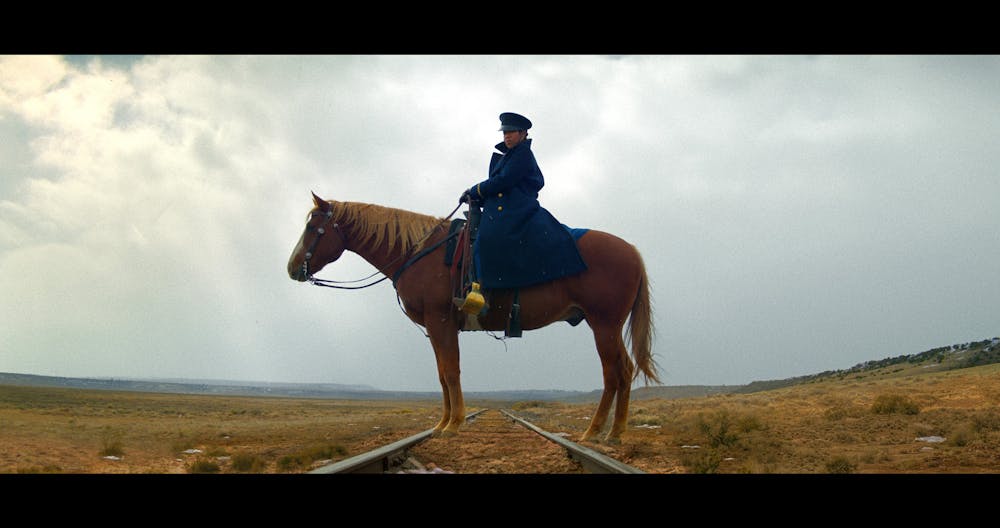Music producer, singer-songwriter and director Jeymes Samuel’s “The Harder They Fall” is not a typical Hollywood Western. The film score is bold with contemporary pop sounds, the sets are pristine — rarely cloaked in dust — and the characters, although beaten up, are not afraid to laugh at themselves every once in a while.
Samuel has stuck to certain hallmarks of the genre. After all, what would a Western be without two characters, twenty feet apart, making eye contact in slow motion? But he’s also jangled everything up enough so that the film doesn’t come off as formulaic. He has, in effect, taken all those yellowing, antiquated scenes of America’s Old West and infused them with something new.
While the film’s plot is entirely fictional, audiences immediately know that the characters are not. The film opens with words splashed across a black screen, a stark reminder that “These. People. Existed.” Samuel has taken actual American cowboys — Nat Love (Jonathan Majors), Cherokee Bill (LaKeith Stanfield), Rufus Black (Idris Elba) — and thrown them all into the same time and place. The film, as a result, feels much like a family reunion that never happened.
The film opens with the death of Love’s parents, then jumps to a grown-up Love who has become a gritty, experienced cowboy. Love’s mission is not an inconspicuous one: He wishes to kill Rufus Black, the man who murdered his mother and father.
The rest of the film consists mostly of a standoff between two main gangs. Shortly after Love learns Black has been released from prison, he leaps at the opportunity to finally act on the personal vendetta he has sought to fulfill since childhood. He then rashly leads his gang to Black’s home town, Redwood City.
The two men are different leaders, but each is equally effective — Love, the younger of the two, is impulsive and driven by blind revenge, while Black is more seasoned with a harder exterior. But both, undeniably, have a flourish of self-confidence, a style that distinguishes the two men from the rest of the cowboys.
Style, in fact, is something the entire film is steeped in. From the score to the sets to the clever shots of lone figures, everything is bright, vivid and intentional. Redwood City at first appears like a town out of any other Western, featuring a small church, a couple of saloons and a dirt-covered main street that leads up to an equally dusty town square. It feels like a movie set — placed and contained — but this characteristic ends up working to the film’s benefit. The meticulous details align to form a visually striking yet altogether cohesive backdrop. Every couch fits in the right corner; every curtain pattern complements the wallpaper.
Such a set is only fitting for Samuel’s stellar ensemble. An impressive backdrop bolsters big moments on screen, such as when Regina King makes an entrance as Trudy Smith (the only female member in the Rufus Black gang) to face a moving train on horseback. Idris Elba, Jonathan Majors, Zazie Beetz, RJ Cyler and many more all give memorably sincere performances. A small surprise came in the form of Danielle Deadwyler, who made the sharp-witted and determined Cuffee one of the film’s most endearing and defiant characters. As one of the two only female members of the Nat Love gang, the audience can’t help but cheer her along the trajectory toward triumph alongside her male counterparts.
There is something to sympathize with in most of Samuel’s cast. Even Black is not driven solely by blood and money. Jim Beckworth adds comedy, Smith is marred by a painful history and Love is the underdog which one can’t help but cross their fingers for.
The most cliched part of the movie (excluding its requisite Western flourishes) comes in the form of Nat and Mary Field’s (Zazie Beetz) romance. The two are frequently depicted in states of desperation: on a cliff, having to part, not able to say to each other what they truly feel. Their relationship is a somewhat kitschy one, but it also speaks to Nat’s naivety about love.
The film’s writing is blunt and honest, a choice likely made to reflect its subject matter. The on-screen legends are ones often neglected in American history. Black cowboys made up so much of the Old West, and yet the cinematic world has repeatedly failed to mention them. Samuel’s choice to present these figures with such unadorned language further points audiences to the fact that they were just as real and relevant as Billy the Kid or Butch Cassidy.
Ultimately, “The Harder They Fall” melds elements of typical Westerns with those of contemporary society all the way up until its end. The final scenes are layered with intentionally clashing elements, such as a blend of opera music and down-and-dirty brawls. These stylistic choices successfully assert that there might still be a place in modern cinema for Westerns after all.

Rya is an Arts & Culture editor from Albany, NY. She is a senior studying English and Literary Arts, and her favorite TV show is Breaking Bad.





